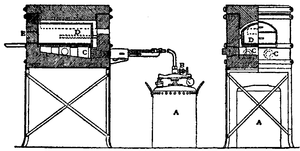Muffle furnace


A muffle furnace (sometimes retort furnace in historical usage) is a furnace in which the subject material is isolated from the fuel and all of the products of combustion, including gases and flying ash.[1] After the development of high-temperature electric heating elements and widespread electrification in developed countries, new muffle furnaces quickly moved to electric designs.[2]
Today, a muffle furnace is (usually) a front-loading box-type oven or kiln for high-temperature applications such as fusing glass, creating enamel coatings, ceramics and soldering and brazing articles. They are also used in many research facilities, for example by chemists in order to determine what proportion of a sample is non-combustible and non-volatile (i.e., ash). Some digital controllers allow RS232 interface and permit the operator to program up to 126[3] segments, such as ramping, soaking, sintering, and more. Also, advances in materials for heating elements, such as molybdenum disilicide, can now produce working temperatures up to 1,800 degrees Celsius (3,272 degrees Fahrenheit), which facilitate more sophisticated metallurgical applications.
The term muffle furnace may also be used to describe another oven constructed on many of the same principles as the box type kiln mentioned above, but takes the form of a long, wide, and thin hollow tube used in roll to roll manufacturing processes.
Both of the above-mentioned furnaces are usually heated to desired temperatures by conduction, convection, or blackbody radiation from electrical resistance heating elements. Therefore, there is (usually) no combustion involved in the temperature control of the system, which allows for much greater control of temperature uniformity and assures isolation of the material being heated from the byproducts of fuel combustion.
References
- ↑ Bulletin - United States Geological Survey, Issues 47-54, 1889, pp. 180 (834)
- ↑ Electric Muffle Furnace, C.A. Crowley, Popular Mechanics, 67:6, June 1937, pp. 941-945
- ↑ StableTemp Furnace Datasheet
| Wikimedia Commons has media related to Muffle furnaces. |
